
Franconia is a region of Germany, characterised by its culture and East Franconian dialect. Franconia is made up of the three Regierungsbezirke of Lower, Middle and Upper Franconia in Bavaria, the adjacent, Franconian-speaking South Thuringia, south of the Thuringian Forest—which constitutes the language boundary between Franconian and Thuringian—and the eastern parts of Heilbronn-Franconia in Baden-Württemberg.

The Main is the longest tributary of the Rhine. It rises as the White Main in the Fichtel Mountains of northeastern Bavaria and flows west through central Germany for 525 kilometres (326 mi) to meet the Rhine below Rüsselsheim, Hesse. The cities of Mainz and Wiesbaden are close to the confluence.

The Bavarian Forest National Park is a national park in the Eastern Bavarian Forest immediately on Germany's border with the Czech Republic. It was founded on 7 October 1970 as the first national park in Germany. Since its expansion on 1 August 1997 it has covered an area of 24,250 hectares. Together with the neighbouring Czech Bohemian Forest the Bavarian Forest forms the largest contiguous area of forest in Central Europe.
The Regen is a river in Bavaria, Germany, and for a short distance in the Czech Republic. It is a left tributary of the Danube, at Regensburg, Germany.

The Schluchsee is a reservoir lake in the district of Breisgau-Hochschwarzwald, southeast of the Titisee in the Black Forest near Freiburg im Breisgau, Germany.

The Franconian Circle was an Imperial Circle established in 1500 in the centre of the Holy Roman Empire. It comprised the eastern part of the former Franconian stem duchy—roughly corresponding with the present-day Bavarian Regierungsbezirke of Upper, Middle and Lower Franconia—while western Rhenish Franconia belonged to the Upper Rhenish Circle. The title of a "Duke of Franconia" was claimed by the Würzburg bishops.

A hammer mill, hammer forge or hammer works was a workshop in the pre-industrial era that was typically used to manufacture semi-finished, wrought iron products or, sometimes, finished agricultural or mining tools, or military weapons. The feature that gave its name to these workshops was the water-driven trip hammer, or set of hammers, used in the process. The shaft, or 'helve', of the hammer was pivoted in the middle and the hammer head was lifted by the action of cams set on a rotating camshaft that periodically depressed the end of the shaft. As it rose and fell, the head of the hammer described an arc. The face of the hammer was made of iron for durability.

The Großer Arber ; Czech: Velký Javor, "Great Maple") or Great Arber, is the highest peak of the Bavarian/Bohemian Forest mountain range and in Lower Bavaria, with an elevation of 1,455.5 metres (4,775 ft). As a result, it is known in the Lower Bavarian county of Regen and the Upper Palatine county of Cham as the "King of the Bavarian Forest". Its summit region consists of paragneiss.

The Bavarian State Archaeological Collection in Munich is the central museum of prehistory of the State of Bavaria, considered to be one of the most important archaeological collections and cultural history museums in Germany.

Bundesstraße 22 is a German federal highway that runs from Würzburg in Lower Franconia, through the Upper Franconian cities of Bamberg and Bayreuth and the Upper Palatine town of Weiden, to Cham. The highway acts as a bypass for the Upper Franconian villages of Seybothenreuth and Speichersdorf as well as the Upper Palatine towns of Kemnath, Erbendorf, Oberviechtach and Rötz, running past Cham (Oberpfalz), where it joins the B 20 and B 85 highways.

The Rannasee is an artificial freshwater lake in Austria and in Germany. The reservoir is located along the Ranna River and is the largest lake in the Bavarian Forest
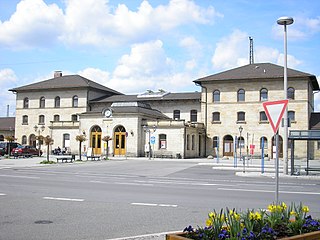
Lichtenfels station is in the town of Lichtenfels in Upper Franconia in the German state of Bavaria. It is a regional rail hub and a former ICE stop on the Hamburg–Berlin Munich route and is classified by Deutsche Bahn as a station of category 3.
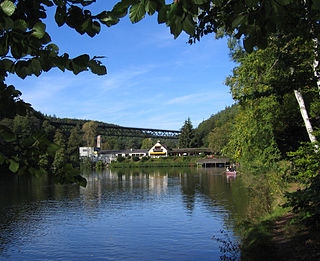
The Eiswoog is a reservoir, roughly six hectares in area, on the Eisbach stream, locally also called die Eis, in the German state of Rhineland-Palatinate. It is oriented from south to north in the water meadows near the source of the stream in part of the northern Palatinate Forest known as the Stumpfwald.
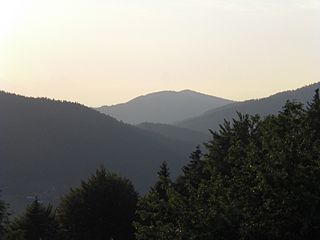
The Anterior Bavarian Forest, also variously called the Vorderer Forest, Vorderer Wald or Danube Hills, is part of the Bavarian Forest, a low mountain range in Germany.

The Eschenberg near Kirchdorf im Wald in the Bavarian county of Regen is a mountain, 1,042 m above sea level (NN), in the Bavarian Forest.
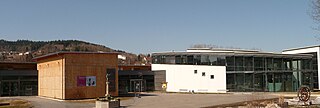
The Frauenau Glass Museum in Frauenau in the Lower Bavarian county of Regen, previously a communal facility, has become a state-owned organisation since early 2014 called the State Museum of the History of Glass Culture run by the Free State of Bavaria. The museum curator is the art-historian, Karin Rühl.
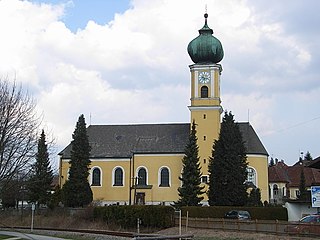
The Church of the Assumption of the Virgin Mary is the Roman Catholic parish church of the town of Frauenau in the county of Regen in the Bavarian Forest in Germany.

The Steinbachtal Dam is a dam in the city of Euskirchen, North Rhine-Westphalia south of Euskirchen-Kirchheim.

The House of Poschinger is an ancient Bavarian noble family. Its origin date back to the year 1140. The family received the rank of Knights of the Holy Roman Empire. The Frauenau branch rose to the rank of Barons (Freiherr) in the Kingdom of Bavaria and held a hereditary seat in the House of Councillors.
Hippolyt Theodor Wilhelm Georg Benedikt Johannes Maria Baron Poschinger of Frauenau was a German businessman, forest manager and politician.


















